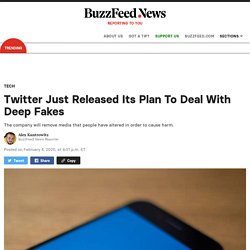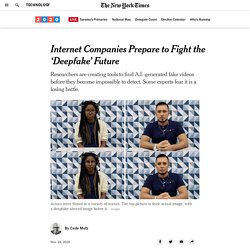

Tool to Help Journalists Spot Doctored Images Is Unveiled by Jigsaw. A doctored, phony image of President Barack Obama shaking hands with President Hassan Rouhani of Iran.

A real photograph of a Muslim girl at a desk doing her homework with Donald J. Trump looming in the background on television. It is not always easy to tell the difference between real and fake photographs. But the pressure to get it right has never been more urgent as the amount of false political content online continues to rise. On Tuesday, Jigsaw, a company that develops cutting-edge tech and is owned by Google’s parent, unveiled a free tool that researchers said could help journalists spot doctored photographs — even ones created with the help of artificial intelligence.
Jigsaw, known as Google Ideas when it was founded, said it was testing the tool, called Assembler, with more than a dozen news and fact-checking organizations around the world. The tool is meant to verify the authenticity of images — or show where they may have been altered. Twitter Will Label And Remove Deepfake Videos, Images, And Audio Starting In March. Twitter will soon begin removing altered videos and other media that it believes threatens people’s safety, risks mass violence, or could cause people to not vote.

It will also start labeling significantly altered media, no matter the intent. The company announced the new rule Tuesday. It will go into effect March 5. “You may not deceptively share synthetic or manipulated media that are likely to cause harm,” Twitter said in a blog post. “In addition, we may label Tweets containing synthetic and manipulated media to help people understand the media’s authenticity and to provide additional context.”
Twitter's new policy arrives amid growing worries that deepfakes and other manipulated media could have an impact on the 2020 election and beyond. “Part of our job is to closely monitor all sorts of emerging issues and behaviors to protect people on Twitter,” Del Harvey, Twitter's vice president of trust and safety, said on a Tuesday call with reporters. What should newsrooms do about deepfakes? These three things, for starters. Headlines from the likes of The New York Times (“Deepfakes Are Coming.

We Can No Longer Believe What We See“), The Wall Street Journal (“Deepfake Videos Are Getting Real and That’s a Problem“), and The Washington Post (“Top AI researchers race to detect ‘deepfake’ videos: ‘We are outgunned’“) would have us believe that clever fakes may soon make it impossible to distinguish truth from falsehood. Deepfakes — pieces of AI-synthesized image and video content persuasively depicting things that never happened — are now a constant presence in conversations about the future of disinformation. These concerns have been kicked into even higher gear by the swiftly approaching 2020 U.S. election.
A video essay from The Atlantic admonishes us: “Ahead of 2020, Beware the Deepfake.” It Will Soon Be a Crime in China to Post Deepfakes Without Disclosure. Deepfakes — Believe at Your Own Risk. Producer/Director Andréa Schmidt Watch — very closely — as an ambitious group of A.I. engineers and machine-learning specialists try to mimic reality with such accuracy that you may not be able to tell what’s real from what’s not.

If successful, they’ll have created the ultimate deepfake, an ultrarealistic video that makes people appear to say and do things they haven’t. Experts warn it may only be a matter of time before someone creates a bogus video that’s convincing enough to fool millions of people. Over several months, “The Weekly” embedded with a team of creative young engineers developing the perfect deepfake — not to manipulate markets or game an election, but to warn the public about the dangers of technology meant to dupe them. The team picked one of the internet’s most recognizable personalities, the comedian and podcaster Joe Rogan, who unwittingly provided the inspiration for the engineers’ deepfake moonshot.
[Join the conversation about @theweekly on Twitter and Instagram. On a essayé de fabriquer un deepfake (et on est passé à autre chose) L’artiste Ctrl Shift Face, roi des « deepfakes » « Ne croyez pas tout ce que vous voyez sur Internet, OK ?

» Venant de Ctrl Shift Face, la formule, plus qu’une mise en garde, sonne comme un pied de nez. Un sarcasme face à l’effroi provoqué par les fake news, tandis que lui trafique des vidéos pour le simple plaisir de divertir les internautes. Et si Jim Carrey jouait dans Shining ? Et si Elon Musk apparaissait dans 2001, rebaptisé « l’Odyssée de SpaceX » ? Et si Donald Trump interprétait l’avocat véreux de Better Call Saul ? Ces délires de fans, habituellement cantonnés aux discussions de bars ou de forums, sont devenus réalité ces derniers mois grâce aux logiciels permettant de fabriquer des deepfakes (ou hypertrucages), des vidéos dans lesquelles un visage est remplacé par un autre, qui se multiplient sur le Web.
. « De la patience, mais surtout des compétences » Internet Companies Prepare to Fight the ‘Deepfake’ Future. SAN FRANCISCO — Several months ago, Google hired dozens of actors to sit at a table, stand in a hallway and walk down a street while talking into a video camera.

Then the company’s researchers, using a new kind of artificial intelligence software, swapped the faces of the actors. Grover - A State-of-the-Art Defense against Neural Fake News.